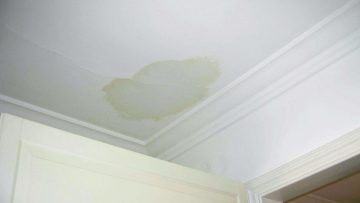There it is: the dreaded ceiling stain. Go ahead, be annoyed. Do a little cursing. It’s warranted, but when you’re ready to work the problem, treat the problem rationally. Knowing what type of contractor you need can save you precious time and money. You need to understand what’s going on. If you’re able to identify the cause, you may find that you’re able to deal with the problem yourself.
If you do need to hire a pro, at least you’ll be reasonably certain of which type of contractor to contact, whether it’s a ceiling repair company or roofing pro.
Common Sources of Water Stains
It shouldn’t be too hard to figure out from what area of the home the water is coming. Whether it’s the roof or an upstairs bathroom, whatever is above the ceiling is usually the source of your moisture problem. If you can’t identify a possible water source above the ceiling stain, you may have a leaky pipe. It’s also not uncommon for water to run along rafters or piping before dropping onto your ceiling, obfuscating the true source of the problem.
Old caulking is a common source of water seepage. Piping or a shower pan that has come into disrepair is also a possibility. Bad piping can mean you have a leak or it can mean your pipe is sweating from inadequate insulation. You may also need to figure out whether your pipes are old and need to be replaced or, if other circumstances, like hard water, is causing premature damage to your pipes.
For water stains coming from your roof, you’ll need to identify the nature of the disrepair. There can be other sources of water seepage from your roof other than a leak. If the water stain occurs after a period of snow, for example, this can indicate the formation of an ice dam, which requires upgrading your insulation, not your roofing. You may still end up contacting a roofing contractor, but knowing this information will help your contractor fix the problem in the most efficient manner possible.
The Water Stain Comes Last
Don’t try to fix the stain or any damaged drywall or plaster until you’re sure you have the moisture problem licked. If the water continues to seep or leak, all your work will have been for nothing. When you’re sure you’ve solved the problem, you may need to tear out the portion of the wall or ceiling if it has been irreparably damaged. If the water stain is purely cosmetic, get some stain-killing primer before repainting. Otherwise, you may find the stain bleeding through the new paint.
A professional handyman can help you with this project if you feel it’s beyond your command. He or she can also provide an estimate of the cost, typically, free of charge.

